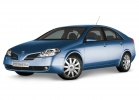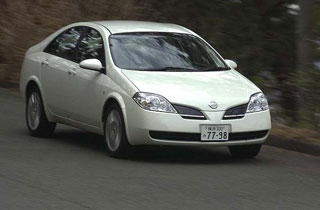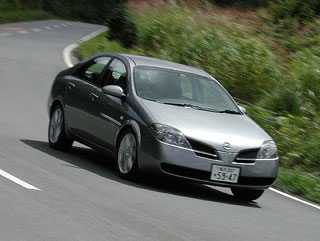Test drive Nissan Primera sedan since 2002 sedan
Snow Maiden
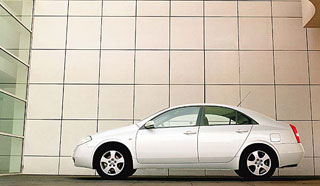 In the Spaniards in winter you can’t ask for snow. Unless high in the mountains. Instead of snow in Barcelona, \u200b\u200bwe were offered something better - the new Nissan Primera.
In the Spaniards in winter you can’t ask for snow. Unless high in the mountains. Instead of snow in Barcelona, \u200b\u200bwe were offered something better - the new Nissan Primera. Take a look at the silhouette of a car, ”suggested a specially trained person from Nissan. - This is what almost any car left in snowfall looks without movement. The wind smoothly blows its body, leaving somewhere more snow, and somewhere less. Therefore, this silhouette is prompted by nature itself, and therefore it is more than harmonious.
 There is something in this metaphor-not a snowy woman, fashioned by man, namely the Snow Maiden. In any case, if you look at the new Nissan Primera in the profile, it is clear that before the windshield and on the lid of the trunk, it was pretty pretty. The snow smoothness of the forms is harmoniously combined with sharp corners and straight lines - take at least the front bumper in which a niche of a license plate, or a tough in the type of hump, which goes from this niche through the hood to the windshield, is made. An example is now really not confused with anything.
There is something in this metaphor-not a snowy woman, fashioned by man, namely the Snow Maiden. In any case, if you look at the new Nissan Primera in the profile, it is clear that before the windshield and on the lid of the trunk, it was pretty pretty. The snow smoothness of the forms is harmoniously combined with sharp corners and straight lines - take at least the front bumper in which a niche of a license plate, or a tough in the type of hump, which goes from this niche through the hood to the windshield, is made. An example is now really not confused with anything. The interior of the car gives the impression of its symmetry and volume. The dashboard peeps out of the central part of the torpedo, and behind the steering wheel gaping an unusual emptiness. The inside of the front doors is, as it were, concave, which harmoniously closes the ellipse formed by the front panel and the backs of the seats, and gives a feeling of space. Behind, compared to the previous model, it also became more spacious. But this is no longer an optical deception, but mathematics - a new example has become 45 mm longer, as much wider and 72 mm higher.
 Reflections. However, the trump cards of the new Primera, of course, are not only in design and dimensions. The designers managed to equip it with so many electronic lotions, about which other segment cars only dream of. Moreover, their governing bodies are grouped in such a way that disputes have already flared up in the Western autoPress. Some argue that Human Machine Interface from Nissan is a parody of BMW Idrive. Others say that both secondary - the joystick for controlling the auxiliary functions of the car was already on Buick Rivera fifteen years ago. The consumer, as a rule, is absolutely on the brake drum, who invented the first - he equally uses both a copy of Xerox and a xerox from Canon.
Reflections. However, the trump cards of the new Primera, of course, are not only in design and dimensions. The designers managed to equip it with so many electronic lotions, about which other segment cars only dream of. Moreover, their governing bodies are grouped in such a way that disputes have already flared up in the Western autoPress. Some argue that Human Machine Interface from Nissan is a parody of BMW Idrive. Others say that both secondary - the joystick for controlling the auxiliary functions of the car was already on Buick Rivera fifteen years ago. The consumer, as a rule, is absolutely on the brake drum, who invented the first - he equally uses both a copy of Xerox and a xerox from Canon.  Although something like this from the new BMW seven inside is still felt, and Japanese eyes, who were leaning in industrial espionage, were clearly mowed towards Munich. But if Bavarian Idrive can easily suppress a user with a low IQ with his cosmic capabilities, then Nissan is more than a simpler, cheaper and therefore more humane. In the end, you can call the doorbell, or you can knock - the result will be almost the same.
Although something like this from the new BMW seven inside is still felt, and Japanese eyes, who were leaning in industrial espionage, were clearly mowed towards Munich. But if Bavarian Idrive can easily suppress a user with a low IQ with his cosmic capabilities, then Nissan is more than a simpler, cheaper and therefore more humane. In the end, you can call the doorbell, or you can knock - the result will be almost the same. In the center of the instrumental panel, the consumer will detect a seven-inch liquid crystal monitor, which displays information about the work of the navigation system, climate control, audio center, auto-diagnostics, parkingate and even phone. By inserting your SIM card into a special nest, you can call a telephone interface to the monitor to the monitor.
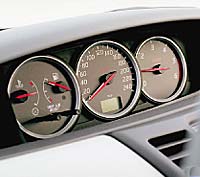 Under the monitor - a plastic tide with a control console. The fact that they are not in vertical, which is familiar to the car, but in a horizontal plane, makes manipulation buttons similar to work on a regular computer keyboard. The console is divided into three segments. The left controls music, the right-climate control, the central-navigation. A block of six numbered buttons located here allows you to quickly activate the desired function - on the display they are also numbered from 1 to 6.
Under the monitor - a plastic tide with a control console. The fact that they are not in vertical, which is familiar to the car, but in a horizontal plane, makes manipulation buttons similar to work on a regular computer keyboard. The console is divided into three segments. The left controls music, the right-climate control, the central-navigation. A block of six numbered buttons located here allows you to quickly activate the desired function - on the display they are also numbered from 1 to 6. MOTOR! CAMERA! Take, for example, the navigation system. It is activated by pressing the button-jacket in the center of the console. You can move along the menu by shaking the same joystick back and forth, the right and left-recall that the BMW controller Idrive moves in eight directions, along the wind rose. For the Enter command, you must again put pressure on the joystick. If necessary, use one of the six multifunctional buttons. It is pleasant that your route can be seen not only in the form of a regular map, but also, as it were, somewhat above, in a three -dimensional image. The 3D graphics are quite boring-it somewhat reminiscent of the very first computer aircraft systems like F-16, but to navigate in Bird View mode is much more comfortable. Nissan is also proud that navigation is not based on the CD, but on the DVD system, which allowed to drive the European map on only one disk. Of course, we are talking about Western Europe, and the inhabitants of the Russian Federation will have to use the torn multi -page navigation lying in the glove compartment.
 But to use another system, which also helps to navigate in space, we are quite along the teeth. If you turn on the rear gear, then a monochrome image of what is happening behind the machine will appear on the display. Again, the BMW seven comes into memory. In it, for the convenience of parking, you seem to see your car on top, and possible obstacles appear on the monitor with multi -colored spots. Everything is much simpler here - a simple camera is installed in the lower edge of the trunk cover, like that that follows our decency in a self -service store.
But to use another system, which also helps to navigate in space, we are quite along the teeth. If you turn on the rear gear, then a monochrome image of what is happening behind the machine will appear on the display. Again, the BMW seven comes into memory. In it, for the convenience of parking, you seem to see your car on top, and possible obstacles appear on the monitor with multi -colored spots. Everything is much simpler here - a simple camera is installed in the lower edge of the trunk cover, like that that follows our decency in a self -service store. However, a well-known part of the above electronics, as well as smart cruise control, xenon headlights or rain sensor-options. You may well be limited to a version with a black and white TV of a smaller diagonal, automatic climate control, as well as electric windows in the front doors and enjoy exclusively communication with the engine and road.
 Spanish ice. For the new Nissan Primera, three gasoline engines and one turbodiesel are provided. The weakest, with a volume of 1.6 liters, is able to develop 109 hp. It is equipped with exclusively five -speed mechanics. Basin 1.8 l with a capacity of 116 hp It can aggregate with a four -speed automatic transmission. Finally, in a two -liter version of 140 hp. The CVT-M6 variator is as standard equipment, and a six-speed manual box-the option. The same box will receive Primera, equipped with a 2.2-liter turbodiesel, a modified version of the power unit installed on the X-Trail model.
Spanish ice. For the new Nissan Primera, three gasoline engines and one turbodiesel are provided. The weakest, with a volume of 1.6 liters, is able to develop 109 hp. It is equipped with exclusively five -speed mechanics. Basin 1.8 l with a capacity of 116 hp It can aggregate with a four -speed automatic transmission. Finally, in a two -liter version of 140 hp. The CVT-M6 variator is as standard equipment, and a six-speed manual box-the option. The same box will receive Primera, equipped with a 2.2-liter turbodiesel, a modified version of the power unit installed on the X-Trail model. In Spain, we got a two -liter car with a variator for a test. The latter is not a new invention, it is still nice to go. Click on gas, the engine is spinning almost to
 6000 vol./Min., And the tachometer arrow is pressed to this figure until the car reaches the maximum for itself 190 km/h or you will not let go of the pedal. No jerks that are familiar when switching an ordinary machine, acceleration goes smoothly, although not as expected from a 140-horsepower engine. The difference can be felt by pushing the handle into the manual mode. Especially the frisky car in the third gear - the driver can choose one of the six fixed gear rates, and the transmission procedure is displayed on the liquid crystal display inside the tachometer dial.
6000 vol./Min., And the tachometer arrow is pressed to this figure until the car reaches the maximum for itself 190 km/h or you will not let go of the pedal. No jerks that are familiar when switching an ordinary machine, acceleration goes smoothly, although not as expected from a 140-horsepower engine. The difference can be felt by pushing the handle into the manual mode. Especially the frisky car in the third gear - the driver can choose one of the six fixed gear rates, and the transmission procedure is displayed on the liquid crystal display inside the tachometer dial. As for the suspension, she did not demonstrate something outstanding, but she did not fail, which is already good.
 The machine swallowed shallow seams between the highway slabs equally well; Without clinging, she climbed into the curbs; I rode along a rocky primer, and when the temperature dropped to -1 degrees in the highlands and the car touchingly warned us about the danger of ice, it was felt how ESP straightens the weather and driver errors. But with Intelligent Cruise Control we had problems. Using a smart system, you strain more from habit, rather than relax. For example, in a bend, when the laser sensor, having lost sight of the car for a second, allows your car to drive faster, and making sure that the interference has not gone in front, begins to slow down. Or when a zealous Spanish is jumping into your row - or, God forbid, Russian - a dashing, the system can be very unintelligent to give the brakes, up to the trigger of ABS.
The machine swallowed shallow seams between the highway slabs equally well; Without clinging, she climbed into the curbs; I rode along a rocky primer, and when the temperature dropped to -1 degrees in the highlands and the car touchingly warned us about the danger of ice, it was felt how ESP straightens the weather and driver errors. But with Intelligent Cruise Control we had problems. Using a smart system, you strain more from habit, rather than relax. For example, in a bend, when the laser sensor, having lost sight of the car for a second, allows your car to drive faster, and making sure that the interference has not gone in front, begins to slow down. Or when a zealous Spanish is jumping into your row - or, God forbid, Russian - a dashing, the system can be very unintelligent to give the brakes, up to the trigger of ABS. 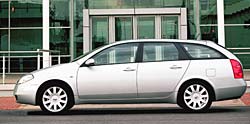 We are waiting for spring. Sales of the Sedan and Primera station wagon in Europe should begin on March 1. Approximately then the machine will appear in Russian Nissan dealers. There are no price lists yet with us or them. However, the company's management has already managed to assure potential buyers that the price of the new item will not be too much from the money that they ask for the predecessor model today and will be competitive ?? The price of Ford Mondeo, who is considered to be the main competitor on Nissan.
We are waiting for spring. Sales of the Sedan and Primera station wagon in Europe should begin on March 1. Approximately then the machine will appear in Russian Nissan dealers. There are no price lists yet with us or them. However, the company's management has already managed to assure potential buyers that the price of the new item will not be too much from the money that they ask for the predecessor model today and will be competitive ?? The price of Ford Mondeo, who is considered to be the main competitor on Nissan. Therefore, we must postpone $ 19-23 thousand and wait until there are almost no cars covered with snow on the street. The one whose silhouette will still resemble a snowdrift and will be the new Nissan Primera.
The text of Dmitry Gronsky, photo of the author and Nissan Europe N.V.
 Model/Modification Nissan Primera
Model/Modification Nissan Primera Manufacturer /country Nissan Motors Co /UK
BODY
Type sedan
Number of doors/places 4/5
ENGINE
Basin type with electronic injection
Front location, transversely
Working volume (cubic cub) 1998
Number/location of cylinders 4/row
Power, kW (L.S.) at about./Min. 103 (140) at 5800
Moment (nm at about./Min.) 192 at 4000
TRANSMISSION
Front drive
Automatic gearbox, variator type, sectral
SUSPENSION
Front independent, multi -link, spring
The rear dependent, spring, multi -link
STEERING
Type gear rack with a hydraulic booster
Min. The diameter of the turn (m) 10.6
Brakes
Front/rear circular ventilated/disk
ABS electronic 4-channel, EBD, ESP
Dimensions/volumes/weight
Length/width/height (mm) 4567/1760/1482
Wheel base (mm) 2680
Equipped mass (kg) 1035
Tires/Disks 215/50 VR17/7JJ-17
Dynamic characteristics
Maximum speed (km/h) 191
Acceleration to 100 km/h (sec.) 10.9
Economy
Fuel consumption (l/100 km, average) 8.8
The price in Moscow is not determined by the manufacturer
Source: "Autopilot"
Video Crash tests Nissan Primera sedan since 2002
Nissan Primera Sedan tests since 2002
Nissan Primera Crash Test sedan since 2002
Krassh Test: Detailed Information29%
Driver and passengers
9%
Pedestrians
Nissan Primera malfunctions since 2002
Nissan Primera Sedan malfunctions: Detailed information| Primera sedan since 2002 | |
|---|---|
| Engine |  |
| Transmission |  |
| Control system and suspension |  |
| Brake system |  |
| Air heating and air conditioning |  |
| Launch and charging system |  |
| Electric components and so on |  |
| Corrosion body stability |  |


